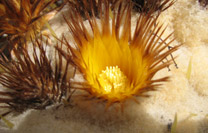 |
 |
|||||||||
 |
 |
|||||||||
|
|
The cultural significance of the plant dates back to the Aztecs who worshipped the cacti gods. Large temples were built for them and human sacrifices were made. The Indians developed a worshipping tradition for the so-called Peyote (Lophophora williamsii). This plant contains mescaline that induces strange hallucinations, but it also has several unpleasant side effects and generally leaves the user with a hangover. The role of Peyote as a god has had an important impact on rituals. Some useful applications of the plant for man:
Note that the cacti you can find at the florist’s shop, garden centre or supermarket cannot be used for these purposes.
|
|||||||||||||||||
|
||||||||||||||||||